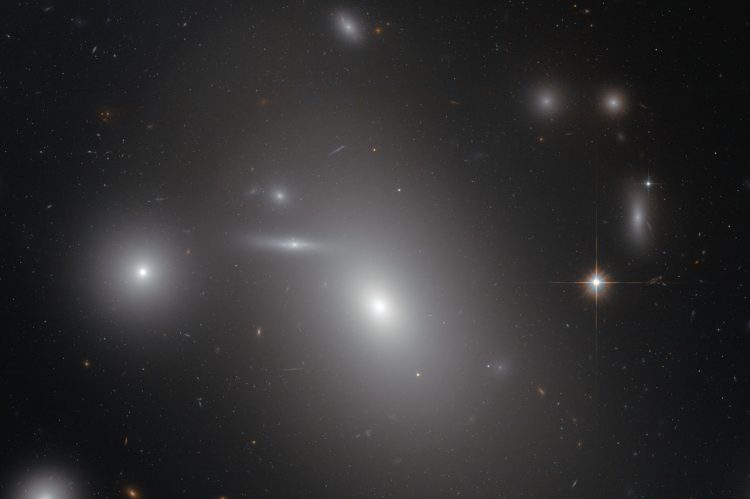The sleeping giant

The sleeping giant NGC 4889 Image credit: NASA & ESA
Located about 300 million light-years away in the Coma Cluster, the giant elliptical galaxy NGC 4889, the brightest and largest galaxy in this image, is home to a record-breaking supermassive black hole.
Twenty-one billion times the mass of the Sun, this black hole has an event horizon — the surface at which even light cannot escape its gravitational grasp — with a diameter of approximately 130 billion kilometres.
This is about 15 times the diameter of Neptune’s orbit from the Sun. By comparison, the supermassive black hole at the centre of our galaxy, the Milky Way, is believed to have a mass about four million times that of the Sun and an event horizon just one fifth the orbit of Mercury.
But the time when NGC 4889’s black hole was swallowing stars and devouring dust is past. Astronomers believe that the gigantic black hole has stopped feeding, and is currently resting after feasting on NGC 4889’s cosmic cuisine. The environment within the galaxy is now so peaceful that stars are forming from its remaining gas and orbiting undisturbed around the black hole.
When it was active, NGC 4889’s supermassive black hole was fuelled by the process of hot accretion. When galactic material — such as gas, dust and other debris — slowly fell inwards towards the black hole, it accumulated and formed an accretion disc. Orbiting the black hole, this spinning disc of material was accelerated by the black hole’s immense gravitational pull and heated to millions of degrees.
This heated material also expelled gigantic and very energetic jets. During its active period, astronomers would have classified NGC 4889 as a quasar and the disc around the supermassive black hole would have emitted up to a thousand times the energy output of the Milky Way.
The accretion disc sustained the supermassive black hole’s appetite until the nearby supply of galactic material was exhausted. Now, napping quietly as it waits for its next celestial snack, the supermassive black hole is dormant. However its existence allows astronomers to further their knowledge of how and where quasars, these still mysterious and elusive objects, formed in the early days of the Universe.
Although it is impossible to directly observe a black hole — as light cannot escape its gravitational pull — its mass can be indirectly determined. Using instruments on the Keck II Observatory and Gemini North Telescope, astronomers measured the velocity of the stars moving around NGC 4889’s centre. These velocities — which depend on the mass of the object they orbit — revealed the immense mass of the supermassive black hole.
More information
The Hubble Space Telescope is a project of international cooperation between ESA and NASA.
Image credit: NASA & ESA
Links
Images of Hubble
Contacts
Mathias Jäger
ESA/Hubble, Public Information Officer
Garching bei München, Germany
Tel: +49 176 62397500
Email: mjaeger@partner.eso.org
Media Contact
All latest news from the category: Physics and Astronomy
This area deals with the fundamental laws and building blocks of nature and how they interact, the properties and the behavior of matter, and research into space and time and their structures.
innovations-report provides in-depth reports and articles on subjects such as astrophysics, laser technologies, nuclear, quantum, particle and solid-state physics, nanotechnologies, planetary research and findings (Mars, Venus) and developments related to the Hubble Telescope.
Newest articles

Witness Groundbreaking Research on Achilles Tendon Recovery
Achilles tendon injuries are common but challenging to monitor during recovery due to the limitations of current imaging techniques. Researchers, led by Associate Professor Zeng Nan from the International Graduate…

Why Prevention Is Better Than Cure—A Novel Approach to Infectious Disease Outbreaks
Researchers have come up with a new way to identify more infectious variants of viruses or bacteria that start spreading in humans – including those causing flu, COVID, whooping cough…

Durable, Efficient, Sustainable: The Rise of Cerium Oxide Thermal Switches
Groundbreaking cerium oxide-based thermal switches achieve remarkable performance, transforming heat flow control with sustainable and efficient technology. Cerium Oxide-Based Thermal Switches Revolutionize Heat Flow Control Thermal switches, which electrically control…



